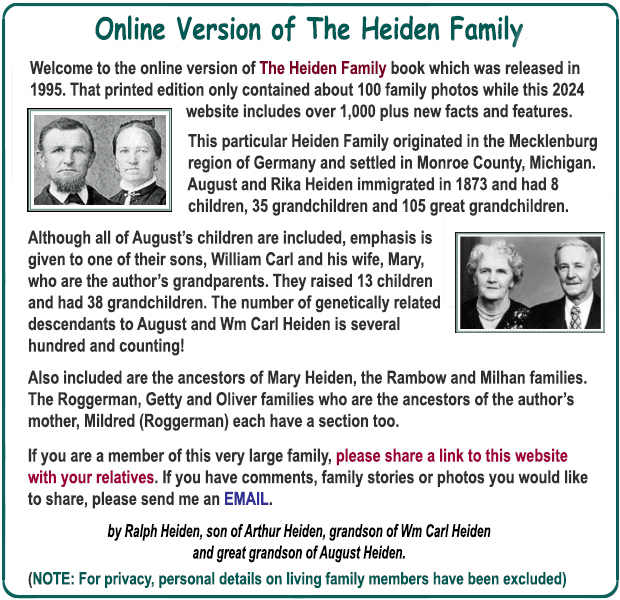|
 |
|
 |
|
|
|
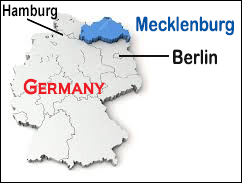 Before
emigrating to Monroe County, Michigan in 1873, this
branch of the Heiden Family originated in the
northern Germany province of Mecklenburg-Schwerin. The
ancestors of the modern day family members were born
and raised in tiny villages surrounded by farms
owned by the Dukes or other elites of the day. After World War II,
this area was under included the former East German
Democratic Republic but is now part of the
re-unified Germany. It is now known as
Mecklenburg-Vorpommern. Before
emigrating to Monroe County, Michigan in 1873, this
branch of the Heiden Family originated in the
northern Germany province of Mecklenburg-Schwerin. The
ancestors of the modern day family members were born
and raised in tiny villages surrounded by farms
owned by the Dukes or other elites of the day. After World War II,
this area was under included the former East German
Democratic Republic but is now part of the
re-unified Germany. It is now known as
Mecklenburg-Vorpommern. |
|
 |
|
|
|
|
|
 |
|
|
 |
|
 |
|
|
|
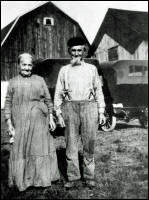 August
and Fredericka (Rika) Heiden were both born and raised in
rural areas of Mecklenburg, Germany in the
mid-1800s. In 1873, they and their first three
children boarded a ship in the Port of Hamburg and
made their way to the United States. Although we
don't know the reason, they settled in
Raisinville Township in Monroe County, Michigan
where they established a farm and had five more
children. August
and Fredericka (Rika) Heiden were both born and raised in
rural areas of Mecklenburg, Germany in the
mid-1800s. In 1873, they and their first three
children boarded a ship in the Port of Hamburg and
made their way to the United States. Although we
don't know the reason, they settled in
Raisinville Township in Monroe County, Michigan
where they established a farm and had five more
children.
As of this writing in
early 2024, they have over 673 direct descendants
and counting. (This does not include almost all of
those born, married adopted, etc. since the 1995
book so the true number is much larger.) |
|
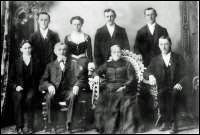
August and Rika (Knaack) Heiden had 8 children (6 of which survived
to adulthood) and 35 grandchildren. All but there
son Herman, remained in Monroe County until their
death. Herman moved to
Isabella County in mid-Michigan
where he raised his family of 4 children. (Click on
image to see a larger, labeled version.) |
|
 |
|
|
|
|
|
 |
|
|
 |
|
 |
|
|
|
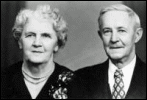 Ralph
Heiden, the author of this history, is a grandson
(one of
38 grandchildren) of
William Carl and Mary (Rambow) Heiden so this wing of the family received extra
attention and detail. Twelve of the thirteen
children established lifelong homes in Monroe
County. Hilda (Heiden) Fuller and her family lived in Battle
Creek in Calhoun County, Michigan. Ralph
Heiden, the author of this history, is a grandson
(one of
38 grandchildren) of
William Carl and Mary (Rambow) Heiden so this wing of the family received extra
attention and detail. Twelve of the thirteen
children established lifelong homes in Monroe
County. Hilda (Heiden) Fuller and her family lived in Battle
Creek in Calhoun County, Michigan.
William
Carl Heiden was the fourth child of
August and Rika (Knaack) Heiden and the first offspring born in the U.S.
in 1874.
He and his wife, the former Mary Rambow, had 13
children who all lived into adulthood. He purchased
the family farm at 8861 Dixon Road in
Raisinville Township and lived there until his death at the age
of 93 in 1967.
As of this writing in
early 2024, they have over 234 direct descendants
and counting. (This does not include almost all of
those born since the 1995
book so the true number is much larger.) |
|
|
|
 |
|
|
|
|
|
 |
|
|
 |
|
 |
|
|
|
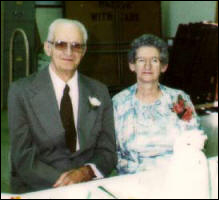 Arthur
Heiden was the eighth child of Wm Carl and Mary (Rambow) Heiden. He and his wife,
Mildred, are my parents so I have given them a separate section of their own. They had seven
children including a stillborn baby and only one, their oldest, Harold is not
alive. So, there won't be much detail on the living children on this online
history. Arthur
Heiden was the eighth child of Wm Carl and Mary (Rambow) Heiden. He and his wife,
Mildred, are my parents so I have given them a separate section of their own. They had seven
children including a stillborn baby and only one, their oldest, Harold is not
alive. So, there won't be much detail on the living children on this online
history.
Instead, we will concentrate on Art and Mildred's
life and her ancestors in the Roggermans from Germany and the Getty family from
Ireland. |
|
 |
|
|
|
|
|
 |
|
|
 |
|
 |
|
|
|
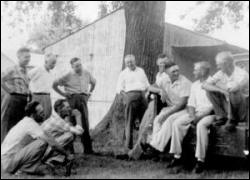
Although a large
family, the members were quite close. Each year for
decades, a family reunion was held on the Fourth of
July. Some years over 100 people would be in
attendance. In the early days, the event was held at
someone's house but as the crowds got bigger, they
moved to larger sites such as the Grange Hall or Ida
Firemen's Park. Many
family activities revolved around the Lutheran
Church. St Matthew Lutheran Church was a couple of
miles from the home of Wm Carl and Mary (Rambow) Heiden. Many
of our relatives are buried in the cemetery behind
the church. In 1964, St Matthew combined with East
Ida Immanuel Lutheran Church and built a new
congregation as
Prince of Peace Lutheran
Church.
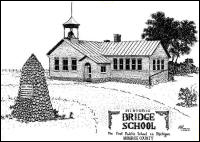 About one mile from the home of Wm Carl and Mary was
Bridge School which was the first public school in
Michigan. It was the typical one-room school
generally with one teacher handling kindergarten to
the 8th grade. About one mile from the home of Wm Carl and Mary was
Bridge School which was the first public school in
Michigan. It was the typical one-room school
generally with one teacher handling kindergarten to
the 8th grade.
For most of the earlier generations
of the Heidens, 8th grade was the end of their
formal schooling. At that point, you would have to
provide your own transportation to a high school in
a local town and that was generally not done. Of Wm
Carl and Mary's 13 children, only the youngest two,
Wilma and Norma got the chance to go to high school.
|
|
 |
|
|
|
|
|
|
|
|
 |
|
 |
|
|
|
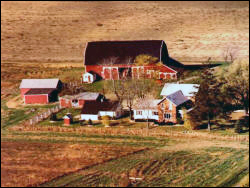 August and Rika (Knaack) Heiden came to Monroe County, Michigan for some long
forgotten reason when they immigrated in 1873. Six of their
eight children lived to adulthood and all but Herman stayed in
the home county. William Carl and Mary (Rambow) Heiden had 13 children,
all of which lived to become adults. All but one, Hilda (Heiden) Fuller,
stayed in Monroe County. August and Rika (Knaack) Heiden came to Monroe County, Michigan for some long
forgotten reason when they immigrated in 1873. Six of their
eight children lived to adulthood and all but Herman stayed in
the home county. William Carl and Mary (Rambow) Heiden had 13 children,
all of which lived to become adults. All but one, Hilda (Heiden) Fuller,
stayed in Monroe County.
In an effort to bring some
perspective to this issue, we have identified over 75 homes,
farms and places of interest such as churches and reunion sites.
These are all in
Raisinville and Dundee Townships within about a
10 mile radius of Wm and Mary (Rambow) Heiden's home at 8861 Dixon Road
shown above.
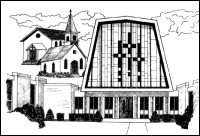 Due to the struggles of the Great
Depression, many of the families did a lot of moving.
Arthur and Mildred (Roggerman) Heiden lived in at least 9 different homes. Many
families had to move in with relatives at various times in their
journey through life. Several of Wm Carl and Mary's children
came back for short periods to live at the home farm. Due to the struggles of the Great
Depression, many of the families did a lot of moving.
Arthur and Mildred (Roggerman) Heiden lived in at least 9 different homes. Many
families had to move in with relatives at various times in their
journey through life. Several of Wm Carl and Mary's children
came back for short periods to live at the home farm.
Click Here for a large size map of Monroe County showing
these locations. |
|
 |
|
|
|
|
|
 |
|
|
 |
|
|
|
 |
|
 |
|
|
|
 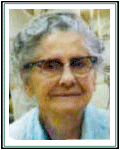 Of
course most of the information encountered during a research of a family comes
from written documents. In 1972, I visited with my great Aunt Agnes (Brockman) Heiden
(right) and
she happened to have an old box full of yellowing documents relating to
August and Rika (Knaack) Heiden's emmigration from Germany to the U.S. Agnes was the daughter of
August's youngest son, John and she was the last of that generation by 1972. If
I had waited a few more years, who knows if those documents would have just
found their way into the trash or a fire. Of
course most of the information encountered during a research of a family comes
from written documents. In 1972, I visited with my great Aunt Agnes (Brockman) Heiden
(right) and
she happened to have an old box full of yellowing documents relating to
August and Rika (Knaack) Heiden's emmigration from Germany to the U.S. Agnes was the daughter of
August's youngest son, John and she was the last of that generation by 1972. If
I had waited a few more years, who knows if those documents would have just
found their way into the trash or a fire.
 I accumulated many, many documents in this
search. Some of them were the originals while others were obtained from
microfilms or from government offices. Several of the items were in German type
or handwritten such as a series of letters written by German relatives to Rika (Knaack) Heiden in the 1920s. All those letters and other documents have been translated
into English for this report. The originals and translations are both included
here. I accumulated many, many documents in this
search. Some of them were the originals while others were obtained from
microfilms or from government offices. Several of the items were in German type
or handwritten such as a series of letters written by German relatives to Rika (Knaack) Heiden in the 1920s. All those letters and other documents have been translated
into English for this report. The originals and translations are both included
here.
|
|
 |
|
|
|
|
|
 |
|
|
 |
|

